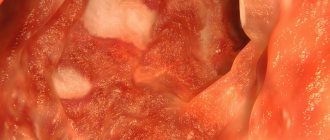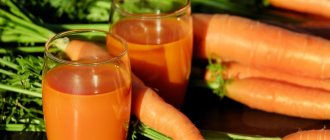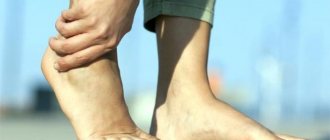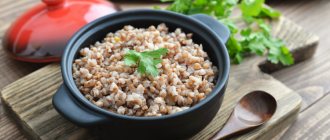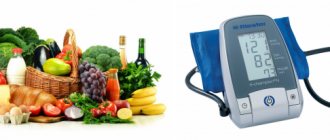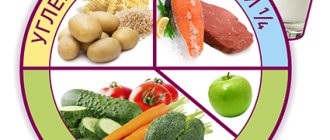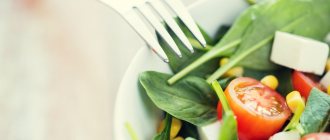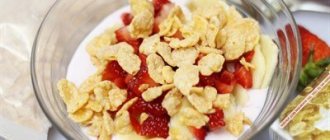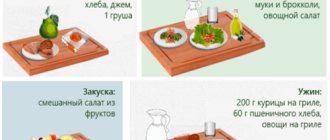Pancreatitis is a severe inflammatory lesion of the pancreas in which the digestive process is disrupted. The causes of the disease can be any, and the pathology itself occurs in several forms. To prevent dangerous consequences and relieve the symptoms of the disease, it is necessary to begin timely therapy, among which a therapeutic diet occupies an important place.
Chemical composition and energy value of dietary table No. 5P (I)
Proteins: 85–90 g (including 45 g animal proteins). Fats: 70–80 g (including 1/3 of the amount - vegetable fats). Carbohydrates: 300–350 g. Daily calorie content: 2,100–2,500 kcal. Free liquid: 1.5–2 l. Table salt: 6–10 g Vitamins: retinol (A) – 0.3 mg, beta-carotene – 10 mg, riboflavin (B2) – 2 mg, thiamine (B1) – 1.3 mg, nicotinic acid (B3) – 6 mg, ascorbic acid (C) – 150 mg. Macroelements: sodium – 3 g, calcium – 0.8 g, magnesium – 0.5 g, phosphorus – 1.3 g. Microelements: iron – 30 mg. Optimal food temperature: from 20 to 50 degrees Celsius.
Why diet
Treatment and nutrition for pancreatitis are interrelated concepts. A properly composed daily diet allows you to solve a number of important problems:
- Elimination of excess load on the inflamed pancreas, which is ensured by fractional meals and the exclusion of difficult-to-digest foods. With pancreatitis, this is a primary task.
- Ensuring complete digestion of basic nutrients. A harmoniously composed menu for pancreatitis ensures the supply of the required amount of nutrients, and an adequate amount of food consumed and balanced dishes contribute to their sufficient digestion under the influence of pancreatic enzymes.
- Prevention of re-exacerbation, because relapse in this disease in the vast majority of cases is associated with errors in nutrition. Therefore, in case of chronic pancreatitis, it is advisable to adhere to the diet constantly.
- Reducing the risk of developing diabetes. The fact is that the pancreas belongs not only to the digestive system, but is also an endocrine (hormonally active) organ. Its tissues contain special formations - the islets of Langerhans. They produce the hormone insulin, and when its production is insufficient, a person develops diabetes mellitus. Chronic or frequently recurring inflammation is fraught with gradual death of functionally active cells, including the islets of Langerhans. That is why pancreatitis is considered one of the main risk factors for the development of diabetes mellitus, and dietary errors are considered an important predisposing factor.
The diet for pancreatitis is aimed at creating conditions under which digestion will be as complete as possible.
Recommended products and dishes of the dietary table No. 5P (I)
Bread: wheat crackers. Soups: slimy cereal soups with vegetable broth or water. Meat dishes: lean meats and skinless poultry in the form of boiled or steamed cutlets, soufflés, quenelles, etc. Fish dishes: boiled or steamed lean fish in the form of cutlets, soufflés. Side dishes: pureed vegetable purees, soufflé, pureed porridge and casseroles made from rice, oatmeal, buckwheat. Dairy products: steam soufflé from unleavened cottage cheese, non-acidic dairy products with caution if tolerated. Eggs: steamed egg white omelet. Snacks: excluded. Sauces: excluded. Sweet dishes: jellies, jelly, fruit mousses, baked apples; sugar – limited, it is recommended to use substitutes. Drinks: weak tea, pureed compotes, rosehip decoction. Fats: fresh unsalted butter in small quantities in dishes.
Nutrition in the acute stage of pancreatitis
In the most acute stage of the disease with severe pain and signs of significant digestive disorders, short-term therapeutic fasting can be used.
This recommendation was voiced by doctors of past centuries, who, in case of acute pancreatitis, prescribed cold (to the area of the inflamed organ), hunger and physical rest to their patients. During this period, non-irritating fortified and alkaline drinks are acceptable; if necessary, parenteral (intravenous) nutrition is prescribed. But the use of enzymes during this period is inappropriate, because the intestines simply do not receive any food that needs digestion. Fasting for acute pancreatitis usually lasts 2–3 days. During this time, the symptoms subside, which makes it possible to switch to dietary nutrition - step by step:
- The first days after fasting, the diet is low-calorie and as gentle as possible. The dishes are puree-shaped, semi-liquid, pureed. They are steamed or boiled and cooled to body temperature when serving. This menu is predominantly carbohydrate-based and does not involve the use of multi-component recipes and spices.
- After the severity of symptoms of pancreatitis decreases, food becomes more varied and high-calorie. At the same time, the menu is expanded gradually, focusing on well-being and the degree of absorption of food. On days 4–5, easily digestible proteins (cottage cheese, boiled lean meat, eggs) are introduced, then a small amount of butter. Vegetable oils are not yet used. Dishes are still boiled and steamed. They are no longer pureed, but chopped or served in the form of soups, soufflés and casseroles.
- In the next 8–12 months, nutrition for pancreatitis remains gentle and fractional, although not so strict. In general, during this period the diet resembles the menu for chronic pancreatitis. Vegetable oils are introduced, dishes become more varied.
From the first days after completing the fast, the diet is supplemented with the use of enzyme preparations. For this, Micrasim® is prescribed, for example. This allows you to partially compensate for the lack of your own pancreatic enzymes and avoid its overload. This is especially important when consuming fatty foods.
Following a diet for pancreatitis is the most important therapeutic point during an exacerbation. It is this that contributes to the gradual normalization of the functioning of the inflamed pancreas and the entire digestive tract. And the prescribed medications help cope with the symptoms, partially relieve the load on the affected organ and compensate for the relative enzyme deficiency.
Excluded foods and dishes of the dietary table No. 5P (I)
From the diet you should exclude fried meat, fish, mushroom broths, saturated vegetable broths, cabbage, turnips, radishes, rutabaga, onions, garlic, leaf salads, sorrel, spinach, radishes, mushrooms, legumes, fatty meats, poultry and fish, liver, pickles, smoked meats, sausages, canned food, lard, animal fat, eggs (except for white omelettes), fresh bread, pastry, flour products, cream, full-fat milk, confectionery, chocolate, cocoa, seasonings, spices and sauces, ice cream, alcoholic drinks, carbonated drinks.
Recipes for every day
Recipes for dietary dishes have some differences from standard options for their preparation. Some ingredients are excluded. The dishes recommended by the 5p Diet are prepared only by stewing, boiling, steaming and baking. The amount of salt, sugar and vegetable oil should be limited.
Borsch:
- To prepare borscht, you will need half a head of Chinese cabbage, one tomato, beets, carrots, three potatoes, a tablespoon of vegetable oil, water, and salt.
- You can add boiled beef to the ingredients, but not meat broth.
- Grind all ingredients and add water.
- The cooking process takes an average of thirty minutes.
- Before serving, you can add a small amount of parsley to the borscht.
Combined vegetable soup:
- To prepare the soup you will need one carrot, three potatoes, a small zucchini, one tomato, a tablespoon of vegetable oil, salt, water.
- Cut all vegetables into cubes (carrots can be grated).
- Pour water over the vegetable stock and add salt.
- The cooking process takes approximately thirty minutes.
Pumpkin cream soup:
When the disease goes into remission, you can slightly diversify pumpkin recipes. To prepare cream soup you will need 500 g of pumpkin pulp, 500 ml of milk, 25 g of cream, salt, a tablespoon of vegetable oil.- Grate the pumpkin pulp or chop it in other ways.
- Pour milk into the pan, add pumpkin and salt.
- The soup is crushed with a blender.
- The workpiece must be boiled again for 5 minutes (can be diluted with cream or milk).
- Dairy products for making soup should be low in fat.
- You can serve the dish with dried bread cubes.
Chicken dumplings:
- To prepare the quenelle you will need 500 g of minced chicken, 100 g of rice, butter, one carrot, salt.
- Pre-boil the rice and carrots (grate the carrots).
- All ingredients are combined into a homogeneous mass (you can add egg white).
- You can cook quenelles by baking or in a double boiler.
- Cooking time depends on the chosen method.
Sample diet menu No. 5P (I)
First breakfast: steamed protein omelet, pureed semi-liquid oatmeal with water, tea. Second breakfast: fruit jelly, tea. Lunch: slimy soup with rice and vegetable broth, chicken quenelles, berry soufflé. Afternoon snack: steamed cottage cheese soufflé, rosehip decoction. Dinner: fish soufflé, vegetable puree, compote. At night: crackers, rose hip decoction.
Sources:
- Order of the Ministry of Health of the Russian Federation No. 330 “On measures to improve clinical nutrition in medical institutions of the Russian Federation” dated 05.08.2003
How to build a diet for pancreatitis
An approximate menu for pancreatitis usually includes 3 main meals (breakfast, lunch, dinner), 2 snacks between them and a fermented milk drink shortly before bedtime.
For breakfast
It is preferable to cook viscous porridges in water; during the period of stable improvement, I use diluted milk for cooking. First, they are ground or served in the form of a soufflé, and then boiled well enough. Breakfast is complemented by a sandwich made from day-old dried bread with a small amount of butter (no more than 10 grams per day). You can eat a piece of low-fat cheese or low-fat ham.
Second breakfast (snack)
may consist of cottage cheese or meat soufflé, baked apple with cottage cheese or honey, sweetened cottage cheese, steamed or baked omelet. Compote or rosehip infusion is also served.
Dinner
consists of various soups, a main course and a drink. Soups are cooked in a second broth and sometimes seasoned with a small amount of sour cream. The second course necessarily includes a protein dish, which can be supplemented with a vegetable or cereal side dish.
For afternoon tea
The choice of dishes is about the same as for the first snack. It can also consist of jelly and biscuits, sometimes banana.
Dinner
should be easy enough to digest, but with enough protein and carbohydrates. These can be soufflés, casseroles, meat and curd quenelles, meat rolls in an omelet, boiled meat/fish, and a side dish is added to them.
For the night
– kefir or other permitted low-fat fermented milk products.
Following a diet for pancreatitis can quickly improve and stabilize the condition for a long time. After all, the therapeutic diet on the 5p table is balanced, provides the body with all the necessary nutrients, spares the affected pancreas as much as possible and helps normalize its function.
In the absence of errors in nutrition, pancreatitis remains compensated for a long time and is not accompanied by uncomfortable symptoms, and the additional use of enzyme preparations allows one to avoid insufficient digestion of food.
Important: before use, read the instructions or consult your doctor.
Indications
The main indication for prescribing dietary table number 5p according to Pevzner is the chronic course of pancreatitis (inflammation of the pancreas) or the period of stabilization of a patient with an acute form of the disease.
Photo: pixabay.com
Diet helps relieve the following symptoms of the disease:
- stomach ache;
- malaise;
- general weakness;
- cardiopalmus;
- disorders of the gastrointestinal tract.
The first part of the diet is applicable for the treatment of convalescent patients, patients with a tendency to transition from acute pancreatitis to chronic. The second part is used in the treatment of patients with chronic disease.
Prohibited Products
Both types of dietary table include prohibited foods. In the first version of the 5p table there are more of them, the second type is softer.
Prohibited foods for the first part of the diet:
The second part of the dietary table number 5p according to Pevzner is inferior to the first in terms of restrictions. The diet allows you to eat:
- bananas;
- low-fat milk soups;
- finely chopped fruits;
- boiled and/or steamed chopped vegetables.
| Products | Used | Kcal per 100 g. | ||
| Fatty meats | ||||
| pork | 16,2/27,8/0 | 398 | ||
| mutton | 16,3/15,1/0 | 305 | ||
| fatty beef | 19,2/12,6/0 | 202 | ||
| duck | 16,4/63/0 | 348 | ||
| goose | 29,4/22,3/0 | 320 | ||
| Meat products | ||||
| ham | 16,8/34,8/0 | 394 | ||
| beef brains | 11,7/8,8/0 | 123 | ||
| beef tongue | 23,8/15,2/0 | 234 | ||
| beef liver | 17,3/2,9/0 | 122 | ||
| boiled sausage | 11,7/28,1/2,8 | 300 | ||
| pork cutlets | 11,7/19,5/9,7 | 262 | ||
| sausages | 10,6/24/1,8 | 266 | ||
| lard | 1,3/89,9/0 | 840 | ||
| Caviar | ||||
| red | 31,4/13,9/0 | 260 | ||
| black | 26,9/16,3/0 | 258 | ||
| pollock | 28,1/2,1/0 | 133 | ||
| Cereals and crumbly porridges made from them | ||||
| pearl barley | 11/0,8/74,2 | 360 | ||
| millet | 11,8/2,8/69,5 | 330 | ||
| unpolished rice | 2,6/0,8/36,2 | 124 | ||
| Eggs (raw are strictly prohibited) | ||||
| boiled whole | 12,5/12/0,7 | 52 | ||
| fried | 12/14,4/1.1 | 58 | ||
| Bakery products | ||||
| baking | 7,6/4,7/54,8 | 260 | ||
| "Borodinsky" bread | 6,6/13,2/40,6 | 200 | ||
| Rye bread | 5,8/1,1/44,5 | 216 | ||
| rye/wheat bread | 6,6/0,9/42,2 | 215 | ||
| grain bread | 8,4/1,6/43,7 | 213 | ||
| Dairy | ||||
| kefir | 2,6/3,2/4,1 | 64 | ||
| mayonnaise | 3,2/66,9/2,8 | 699 | ||
| margarine | 0/82,3/,8 | 698 | ||
| curdled milk | 2,8/3,2/4,2 | 60 | ||
| fatty curdled milk | 3,5/3,9/3,9 | 66 | ||
| cream | 2,6/19,8/3,7 | 210 | ||
| fat sour cream | 2,6/25,3/3,2 | 249 | ||
| fat cottage cheese | 13,2/19,9/2,5 | 251 | ||
| Mushrooms | ||||
| white | 3,4/0,6/1,6 | 32 | ||
| salted mushrooms | 3,5/1,6/0,9 | 31 | ||
| boletus | 0/0/0 | 21 | ||
| boletus | 2,4/0,8/3,4 | 24 | ||
| boletus | 3,5/0,5/3,2 | 22 | ||
| Champignon | 0/0/0 | 24 | ||
| Sweets | ||||
| dark chocolate | 6,1/35,2/49 | 540 | ||
| milk chocolate | 4,8/3,5/52,5 | 550 | ||
| chocolate bars | 4,2/24,8/69,1 | 510 | ||
| halva | 12,5/29,9/50,7 | 526 | ||
| lollipops, caramel | 0/0,2/97,1 | 400 | ||
| marmalade | 0,4/0,2/75,8 | 307 | ||
| popcorn | 2,2/20,6/77,5 | 483 | ||
For any type of diet, it is prohibited to consume alcohol in any form, coffee and caffeine-containing products.
Therapeutic nutrition for chronic form
For patients with chronic pancreatitis, following a diet is a lifelong responsibility, since any dietary errors can cause an exacerbation of the pathology. Each attack of the disease is accompanied by partial replacement of functioning tissues with fibrous ones, which ultimately leads to the development of insufficiency of the secretory function of the gland.
During the period of exacerbation of the chronic form of pancreatitis, accompanied by severe pathological symptoms, the patient is prescribed a strict 7-day diet as in the acute form. After feeling better, the patient is switched to a diet in accordance with table No. 5 P.
Its main characteristics:
- Dishes served to the table must be either pureed or thoroughly chopped;
- the content of protein, fats and carbohydrates meets the physiological needs of the body;
- with poor protein absorption, its percentage decreases due to an increase in carbohydrate content;
- products containing fiber and extractive substances are completely excluded;
- the amount of salt is limited to 6 grams per day;
- fractional meals - up to 6 times a day;
- overeating is unacceptable.
Contraindications
Compliance with the 5 p diet in any form is strictly contraindicated in case of kidney disease:
- glomerulonephritis;
- pyelonephritis;
- glomerulonephritis;
- any form of renal failure (acute, chronic).
Table 5p will have to be abandoned if hepatitis activates (transformation from chronic to acute).
This is due to the increased load on the organ, which is unable to cope with lost food, especially its protein content.
The presence of constipation due to insufficient fatty acids in the diet or intestinal dysfunction is an indication for stopping the diet.
5p table is prohibited when:
- the presence of intestinal diverticula (pouch-like protrusions of the intestinal wall);
- polyps in the intestines or stomach;
- oncological diseases;
- organic pathologies of the intestine, disorders of the regulation of its work on the part of the nervous system;
- after removal of a significant amount of intestines or stomach.
